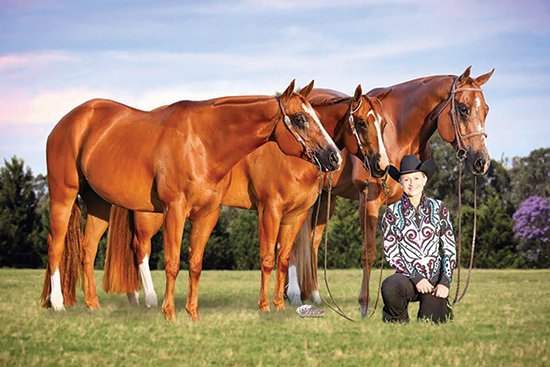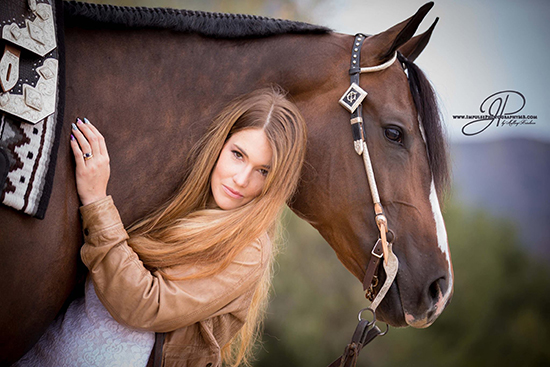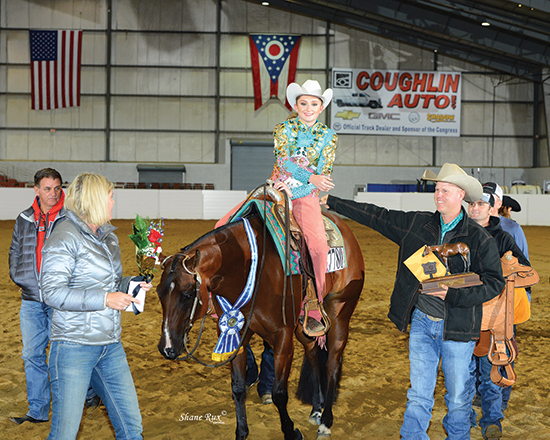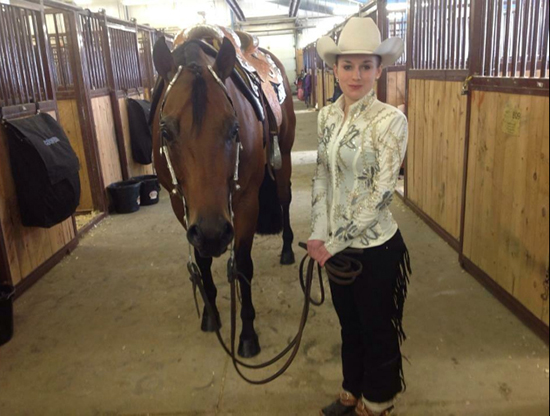 Equine competition may seem like an American hobby, but in fact, individuals across the world share this same passion. When searching large associations like the American Quarter Horse Association (AQHA) or American Paint Horse Association (APHA), you will find that the membership is quite diverse and includes members from countries all over the world.
Equine competition may seem like an American hobby, but in fact, individuals across the world share this same passion. When searching large associations like the American Quarter Horse Association (AQHA) or American Paint Horse Association (APHA), you will find that the membership is quite diverse and includes members from countries all over the world.
But how do competitors make it work when they compete outside of their home country? What challenges arise for these competitors and their trainers, and why do so many competitors choose to come to the United States to compete?
The perspective of an overseas client
Ruby Lang of Mansfield, Victoria, Australia says that competing at the highest level of competition led her to showing in the United States. Lang has successfully competed at some of the highest venues such as the Tom Powers Futurity, National Snaffle Bit Association’s World Show and All American Quarter Horse Congress.
“I started showing Western Pleasure in Australia when I was 13 years old. I was chosen for the Australian Youth World Cup team in 2014 which was held in College Station, Texas. It was my first glimpse of showing in the U.S.,” says Lang. “My parents then allowed me to come to Congress that year to compete on one of my horses. It was an amazing experience, and I think I was hooked.”
Lang had the opportunity to spend six months in 2015 showing around the country with Sliss Show Horses of Gainesville, Texas and is currently working with trainers Brian and Dawn Baker of Baker Show Horses in Sunbury, Ohio.

Ruby Lang
“Trust and common objectives are the only way a long-distance relationship can work with a trainer,” she said.
A concern for many long-distance trainer-exhibitor relationships is the difficulties that arise with practicing. To keep her skills sharp, Lang relies on trainers in Australia, as well as, early arrival to shows to feel prepared when she walks in the show pen.
“I work with trainers in Australia. I currently have my show horses with Kyle and Kristy Mobberley and spend time with them perfecting my craft,” she explained.
When she is competing in the U.S., she tries to arrive one to two weeks before the show to get a feel for the horse she’s showing and to brush up on anything that is needed.
“When you have horses with someone like Brian and Dawn Baker the process is relatively simple as they prepare the horses so well for me,” she said. “However, it was definitely easier to develop a connection with my horse, when I was able to spend an extended time in the U.S.”
Marie-france D’Hondt of Gembloux, Belgium also sees the distance barrier for practice as a challenge she has had to overcome when competing in the U.S.
“It is hard to fly over every five weeks and be ready right away to show,” she said. “I need to find back my points of reference, sit in the saddle and remember what we learned the last time. The horse also must get used to me and my riding. I find the practice sessions must be managed so the horse is also able to get used to this stranger riding it without becoming frustrated.”
Practicing was not the only roadblock.
“I’m blessed to work with my husband. I can work on my computer when needed, so it is very easy for me to organize my travels and work,” she said. “Nevertheless, I have to make sure everything will be fine for my horses and dogs at home. My biggest challenge so far showing here was in September. I was showing in Syracuse and fell ill. I ended up needing surgery and had to fly back home. Thankfully, I had the support and help of my trainer and all of her customers during this difficult time.”
D’Hondt is currently working with trainer Torey Roderick of Troy Green Quarter Horses in Seekonk, Massachusetts. She feels their relationship has worked well because of a strong foundation built on trust.
“A horse trainer is your trust and support, and they are the only voice you can hear in a show pen,” she explained. “To make a relationship work, especially as an outlander, I need even more help, support and trust.”

Cathrin Gutmann
Cathrin Gutmann who lives near Vienna, Austria, also found that competing in the United States was a way to develop a higher skill set for her program at home.
Gutmann, who has been competing in equine events for 16 years, started her U.S. career in 2011 at the All-American Quarter Horse Congress.
“We bought our first real successful horses at the Congress in 2011 and that is when I really saw the quality of horses and quality of riding and showing,” she said. “That’s what really started getting me more interested in doing this. I got more and more into it. I started having horses over here and at home. For two years, I really did every show at home and most of the big shows here. This was a struggle with a child and family so now I’m showing mostly in the States and very little at home.”
In the past five years of competition in the U.S., Gutmann has had the opportunity to work with a several trainers.
“I have worked with Allison Clark, Carl and Trisha Yamber, and Nancy Sue Ryan,” Gutmann said. “I am currently still working with Jay and Kristy Starnes and Michael Colvin. I’m friends with many different trainers and have had several trainers do clinics at our home including Jay and Kristy, Michael Colvin (who comes regularly), Adam Wainscott, and Allison Clark, who has shown with me at a few shows in Europe.”
The ability to work with so many talented professionals has been a wonderful learning experience and method for developing the program that Gutmann has been building at her facility in Austria. However, because of Gutmann’s passion for working with her show partners from the ground up, there have been some challenges to her long-distance relationships in the U.S.
“At home, we have two assistants that are really doing a great job, but as far as riding I do everything myself,” she said. “Whenever I need input, I have great friends in Europe like Dasi (Jadasa Jablonowski), who just won the Congress in the Senior Hunter Under Saddle. She’s a great friend and can give some advice. I have some trainers that can come over and help me, but from the colt breaking and everything we do ourselves. That’s what I really enjoy.”

Abby Rawlings and Jay Starnes
A United States trainer’s perspective
Jay and Kristy Starnes operate Starnes Quarter Horses in Manning, South Carolina. They are currently working with several overseas clients, including the Rawlings Family of Australia, Cathrin Gutman of Austria and Ulf and Veronika Anderson of Sweden.
Kristy said these relationships have been successful due to, “honesty, the same as with our clients based in the U.S.”
Starnes said the biggest challenges for their overseas clients are solved by sensitivity to schedules and early planning.
“Being aware of time changes as to when we can call clients and when they can call us was an adjustment at first,” she said. “For Australia, we need to call them in the evening here which is morning there. Also, arranging our show schedule well in advance has been very beneficial so that our clients can get their flights made in advance for shows.”
Solid communication has also been a foundation for the relationship between Roderick and her client, D’ Hondt.
“I think a good relationship isn’t much different whether it’s overseas or a few hours away,” she said. “The big thing is communication. I don’t want her to feel that it’s like an ‘out of sight, out of mind’ situation. I try to occasionally reach out and update her before she asks, so she doesn’t feel like she’s always the one having to check in. I try to be courteous of the time change and she does the same. Most of my customers live at least an hour away so really it’s just about communication and expectation. I try to keep them in the loop. It takes a few minutes to send a quick message or even a short video if they haven’t seen their horse in a couple months.”
Roderick feels there must be a good bit of strategy for clients that are only able to ride on a limited basis.
“The biggest challenge has been making the riding schedule conducive to both horse and rider,” she explained. “When she’s in town we take advantage of it and get a lot of riding in, but it’s more concentrated.”

Betty Edwards
Roderick prefers to build a team over time and, as they both get better, increase the amount that they ride.
“Marie understands and although she’s here to ride, she allows me to dictate when and how long,” she said. “She’s very agreeable so I try to be the same. We tend to do a lot of short sessions rather than marathon rides.”
Jamie Zuidema of Cumming, Iowa, has had the opportunity to work with Annie Gravett and Betty Edwards, a mother-daughter team from England, for the past 15 years. Zuidema, like Starnes and Roderick, deems communication as the key to keeping this long trainer-client relationship so successful.
“We may go months without seeing Annie and Betty which means they go months without seeing or riding their horses,” he said. “We understand that there is a lot more planning that takes place for them to come and show compared to our U.S. clients. We’ve learned that planning the show schedule ahead of time and communicating about general show logistics has been very helpful.”
There are also challenges that have had to be overcome. Like Roderick, Zuidema said that practicing has definitely been the biggest hurdle for his overseas clients to overcome to find success in the show pen.
“They can’t just come out to the barn and ride once a week or before every show like some of my other clients can,” he explained. “We really have to utilize our time together while at a show.”
Both Gravett and Edwards also purchased horses from Zuidema that they transported home to practice on and show there.
“When they come to the States the only thing they have to work on is getting back into rhythm with their horses here,” Zuidema said. “If they don’t have one that either of them is currently showing here, then Annie tries to have one in training that is only shown in the open.
That way she can watch on the live stream and it gives her a good reason to come and visit the States.”

Jadasa Jablonowski
An overseas trainer’s views
Jadasa Jablonowski has her own all-around training business based in Munich, Germany. There she has accumulated multiple European championships and coached and trained many youth and amateur exhibitors to European championship titles. However, even with all Jablonowski’s success in Europe, she had always dreamed of coming to the United States to compete for a World or Congress championship.
“This sport´s origin is in the U.S. and that´s why, of course, we always look over the pond to see what is going on over there,” Jablonowski said. “Over the years, I was lucky enough to meet some of the best riders in the industry. I met Michael Colvin in 1998 when he was living in Italy and saw him ride and show over here. He was such an inspiration and a far to reach idol for me. Watching him ride and teach left a deep impact on me. This made me want to get better and better.”
In 2004 Jablonowski met Charlie Cole. He was judging a European Championship and offered to answer questions from the exhibitors, after judging was complete. Afterwards, he invited Jablonowski to visit his Highpoint, Performance Horses in Pilot Point, Texas.
“The following years I went to ride with Highpoint more and more often,” she explained. “I learned the Hunt Seat from Beth (Case) and Trail and Western Riding from Charlie and Jason (Martin). I took the knowledge back home and trained my horses over here always trying to make them as good as the horses in the States. For me, it´s really important to go to the United States often to keep up with current styles and trends.”
Jablonowski lists the thrill of tough competition as the number one reason competitors like to show in the United States.
“I think the biggest difference between Europe and the States is the number of horses,” she said. “We do have nice horses in Europe too but not as many as in the States. I think for Europeans it´s very appealing to show in the U.S. because it takes them to the next level of competition. The classes are much deeper than in Europe. It´s very challenging to try to win a trophy in the U.S.”
Lauren Louw of Sydney, Australia has been working in the United States for almost three years for Ty Hornick Quarter Horses in Jamestown, Ohio. She had been working in Australia for about five years prior to her move to the United States. She said there are more opportunities in the United States and that’s why she relocated.
“There are a lot of great horsemen in Australia and I was fortunate enough to learn from two of the top pleasure trainers there,” she said. “But the numbers in the U.S. are so large. Coming over here, people have so many horses and they need you to ride them, and that’s how you learn. You can learn a lot from listening and watching but you don’t get the feel unless you are in that saddle and doing the work.”
Louw also enjoys the comradery in the U.S. that may not be found in other countries.
“The numbers are so high here in the U.S. compared to Australia that everyone is content,” she explained. “There are plenty of horses to ride and lots of nice horses so there’s no internal competition. A lot of trainers over here are on the same page, and everyone’s friendly and helpful, and that really doesn’t happen in a lot of other places and industries. I think a lot of people over here don’t realize that because they’ve never lived outside of it, but it really is a family.”
Louw cited many examples of how professionals have helped in building her skill sets.
“I had to show Trail on a horse and had never really shown it competitively,” she recalled. “I was at a show and Brent Maxwell noticed I was experiencing some road bumps. He took an hour and a half out of his time to help coach me through this course. It was so heartwarming. He didn’t need to take time out of his day, everyone is busy. I ended up showing that horse again at a circuit two weekends later and I won. And I knew I couldn’t have done that without Brent Maxwell. And that’s just one example of the kindness that I’ve experience since working here.”



You must be logged in to post a comment Login